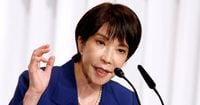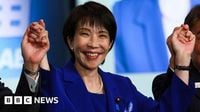On October 4, 2025, Japan’s long-dominant Liberal Democratic Party (LDP) took a historic step by electing Sanae Takaichi as its new leader, setting the stage for her likely appointment as the nation’s first female prime minister. The decision, made by a select group of 295 LDP parliamentarians and roughly one million dues-paying party members—about 1% of Japan’s population—marks a significant moment in a country often criticized for its slow progress on gender equality. Yet, the path ahead for both Takaichi and her party is anything but straightforward.
Takaichi, 64, is no newcomer to the political spotlight. As a former Economic Security Minister and a prominent figure from the party’s right-wing, she has long been recognized for her hard-line stances and deep admiration for former British Prime Minister Margaret Thatcher. According to the Associated Press, Takaichi is also a protege of the late Shinzo Abe, Japan’s longest-serving prime minister, and is known for her regular visits to the controversial Yasukuni Shrine—a site that stirs strong feelings in Japan’s Asian neighbors due to its associations with wartime militarism.
Her victory came after a runoff against Agriculture Minister Shinjiro Koizumi, the son of another former prime minister, Junichiro Koizumi. The leadership contest was prompted by the resignation of Prime Minister Shigeru Ishiba, whose government suffered a string of stinging election defeats and found itself in the minority in both chambers of parliament. The LDP, which has governed Japan almost continuously since 1955, is now fighting to restore public trust and political stability after what many see as a crisis point for the party.
As reported by CNN, Takaichi’s main challenge will be to unify a party that has lost its electoral footing and faces growing pressure from both the left and right. In her victory speech, Takaichi acknowledged the weight of the moment: “I made history for the LDP,” she said, expressing gratitude to her supporters and emphasizing the daunting tasks ahead. “Right now, instead of savoring joy, I'm overwhelmed by what's ahead, a mountain of challenges that I have to tackle with help from all of you.” She called on her fellow lawmakers to help transform the party into a force that can “change the people's worries into hope.”
But what sort of leader will Takaichi be? While her rise is historic, her policy positions are less likely to please those hoping for a liberal turn. As noted by Reuters, Takaichi hails from the traditionalist wing of the LDP and is considered one of its most conservative members. During the campaign, she and her rivals all described themselves as “moderately conservative” to signal a willingness to cooperate with opposition groups. Yet, experts and critics have pointed out that the campaign largely avoided divisive issues such as gender equality, same-sex marriage, and the party’s own political funding scandals—an omission that has raised doubts about the LDP’s ability to truly regain public trust.
Instead, Takaichi and her competitors focused on economic revival, national security, and immigration. Takaichi has voiced support for aggressive monetary easing and big fiscal spending, echoing the economic policies of her mentor Abe. She also backs a stronger military, enhanced cybersecurity, and tougher regulations on foreign tourists and laborers. In the campaign, she criticized what she described as lax policies on foreign offenders and called for a reconsideration of rules allowing people with “completely different cultures and backgrounds” into Japan, as cited by Al Jazeera. Such rhetoric, while resonating with some conservative voters, has also drawn criticism from academics and activists who argue that Takaichi “has no interest in women’s rights or gender equality policies,” according to Yuki Tsuji, a political scientist at Tokai University.
Immigration has become an especially potent issue, with the LDP facing competition from the populist Sanseito party, which has gained traction by framing immigration as a “silent invasion” responsible for a host of societal ills. Both Takaichi and Koizumi sought to appeal to voters worried about public safety and the impact of foreign workers and tourists. Koizumi, for his part, warned that “illegal employment of foreigners and the worsening of public safety are leading to anxiety among local residents.” Such alarmism is notable in a country where people born abroad make up just 3% of the population, as highlighted by Al Jazeera.
Despite the LDP’s internal divisions and recent electoral setbacks, Takaichi’s path to the prime ministership appears clear. The party remains the largest in the lower house of parliament, which determines the national leader, and opposition groups are highly fragmented. A formal parliamentary vote to confirm the new prime minister is scheduled for mid-October, and Takaichi is widely expected to secure the position.
However, she will not have the luxury of a honeymoon period. The LDP-led coalition no longer holds majorities in either chamber, meaning Takaichi will need to build bridges with opposition lawmakers to govern effectively. According to CNN, the party is likely to seek an expanded coalition with the moderate centrist Komeito and other centrist opposition parties. This pragmatic approach may help Takaichi push through her policy agenda, but it will also require delicate negotiation and compromise—a test for any leader, let alone one with a reputation for hard-line positions.
Takaichi’s first major diplomatic challenge is already on the horizon. Reports from multiple outlets, including the Associated Press, indicate that a summit with U.S. President Donald Trump is being planned for late October, coinciding with the Asia-Pacific Economic Cooperation summit in South Korea. Trump, known for his transactional approach to alliances, may press Japan to increase its defense spending—a perennial point of tension in the U.S.-Japan relationship. How Takaichi navigates this high-stakes meeting could set the tone for her administration’s foreign policy.
Domestically, Takaichi faces a daunting array of issues: an aging population, a faltering economy, and growing unease about immigration and social cohesion. The LDP, once the unassailable pillar of Japanese politics, now finds itself in unfamiliar territory, needing to win back skeptical voters and forge new alliances. As Koizumi put it during the campaign, the party is in a “crisis” and needs a thorough overhaul to start afresh.
For all the symbolism of Takaichi’s rise as the first woman to lead Japan, the substance of her policies and the challenges she faces will determine whether this moment signals real change or simply a new face at the helm of an old order. The coming weeks, with a parliamentary vote and a diplomatic test looming, will reveal whether Takaichi and the LDP can turn a historic election into a turning point for the country.
As Japan stands at this political crossroads, all eyes are on Sanae Takaichi—a leader whose ascent breaks barriers but whose leadership will be judged by her ability to unite a divided party, restore public trust, and steer the nation through uncertain times.


